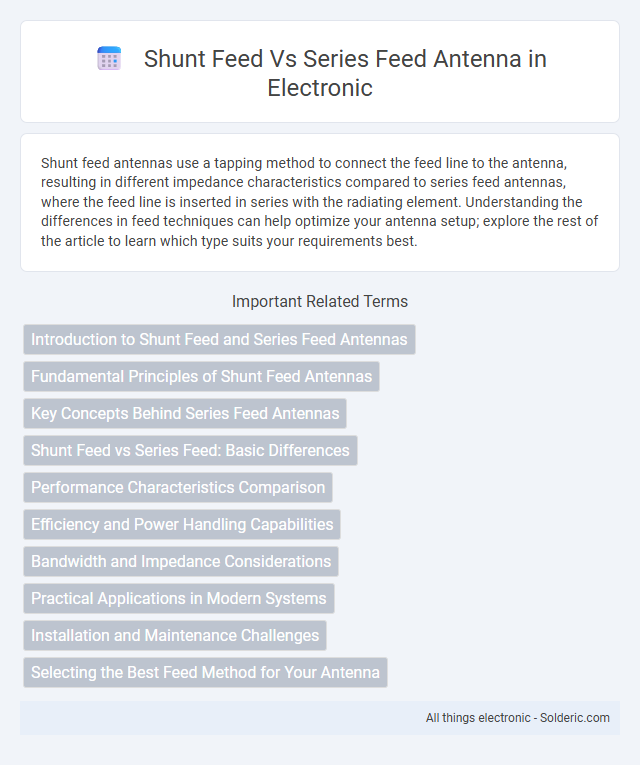Shunt feed antennas use a tapping method to connect the feed line to the antenna, resulting in different impedance characteristics compared to series feed antennas, where the feed line is inserted in series with the radiating element. Understanding the differences in feed techniques can help optimize your antenna setup; explore the rest of the article to learn which type suits your requirements best.
Comparison Table
| Feature | Shunt Feed Antenna | Series Feed Antenna |
|---|---|---|
| Feed Method | Connected in parallel (shunt) to the antenna element | Connected in series with the antenna element |
| Impedance Matching | Easier for high impedance matching | Better for low impedance matching |
| Common Use | Yagi-Uda antennas, especially for director elements | Dipole antennas and simple wire antennas |
| Radiation Pattern Impact | Minimal disturbance, maintains element current | Can alter current distribution, affecting pattern |
| Bandwidth | Typically narrower bandwidth | Generally wider bandwidth |
| Construction Complexity | More complex due to parallel feed | Simpler construction and feed arrangement |
Introduction to Shunt Feed and Series Feed Antennas
Shunt feed antennas employ a parallel connection to excite the radiating element, enhancing impedance matching and bandwidth by injecting current directly into the antenna structure. Series feed antennas use a direct series connection along the antenna element, resulting in a simpler design with a narrow bandwidth and higher impedance, commonly found in dipole configurations. Both feeding methods impact antenna performance parameters such as gain, radiation pattern, and operational frequency range, critical for applications in communication systems.
Fundamental Principles of Shunt Feed Antennas
Shunt feed antennas operate by connecting the transmission line in parallel with the antenna element, creating a current coupling that improves impedance matching and bandwidth performance. This method allows the antenna to present a low input impedance at the feed point, facilitating efficient power transfer and minimizing signal reflection. Fundamental to the design is the use of a quarter-wave transmission line stub or similar reactive element to achieve the required phase shift and resonance.
Key Concepts Behind Series Feed Antennas
Series feed antennas operate by connecting each radiating element in a continuous line, allowing the RF current to flow sequentially through all elements. This design ensures a consistent phase progression, enhancing directivity and gain, making them ideal for applications requiring high radiation efficiency. Your antenna's performance depends on precise impedance matching along the transmission path to minimize signal loss and maximize bandwidth.
Shunt Feed vs Series Feed: Basic Differences
Shunt feed antennas use a side connection to the driven element, providing impedance matching and increased bandwidth by injecting current into the element at a point other than the end. Series feed antennas connect the feedline directly in series with the driven element, resulting in simpler construction but typically narrower bandwidth and less impedance flexibility. The choice between shunt feed and series feed impacts antenna performance, including radiation pattern stability and feedpoint impedance characteristics.
Performance Characteristics Comparison
Shunt feed antennas exhibit improved impedance matching and broader bandwidth due to their parallel feed configuration, enhancing signal strength and reducing losses in high-frequency applications. Series feed antennas offer greater simplicity and ease of construction but typically present narrower bandwidth and increased susceptibility to signal reflection, impacting overall efficiency. The choice between shunt and series feed designs directly influences parameters such as VSWR, gain stability, and noise figure, which are critical for optimized wireless communication performance.
Efficiency and Power Handling Capabilities
Shunt feed antennas typically offer higher efficiency due to reduced power loss in the feed system, making them suitable for low to moderate power applications. Series feed antennas often exhibit lower efficiency caused by increased feedline losses but can handle higher power levels because of their simple feed structure and better heat dissipation. Choosing between shunt feed and series feed antennas depends on the balance between maximizing efficiency and meeting the power handling requirements of the transmission system.
Bandwidth and Impedance Considerations
Shunt feed antennas typically offer wider bandwidth due to better impedance matching across a range of frequencies, making them ideal for applications requiring multi-band performance. Series feed antennas often exhibit narrower bandwidth with more sensitive impedance characteristics, requiring precise tuning to achieve optimal performance. Understanding these differences helps you select the right antenna based on your bandwidth needs and impedance stability requirements.
Practical Applications in Modern Systems
Shunt feed antennas are widely used in mobile communication systems and Wi-Fi routers due to their compact size and ease of integration with printed circuit boards, offering efficient impedance matching in compact devices. Series feed antennas find practical application in RFID systems and radio broadcasting where higher power handling and narrow bandwidth are required, providing stable performance in harsh environments. Choosing between shunt feed or series feed directly impacts your system's efficiency, frequency stability, and adaptability to modern communication standards.
Installation and Maintenance Challenges
Shunt feed antennas require precise placement and insulation during installation to ensure proper current distribution, making adjustments more complex compared to series feed antennas. Series feed antennas are typically easier to install and maintain due to their simpler feed line configuration and fewer critical connection points. You may find that shunt feed models demand more frequent inspections and specialized tools for maintenance to avoid performance degradation.
Selecting the Best Feed Method for Your Antenna
Choosing the best feed method for your antenna depends on factors such as bandwidth, impedance matching, and application requirements. Shunt feed antennas offer broader bandwidth and simpler matching for broadband applications, while series feed antennas provide better control of current distribution for narrowband performance. Examining your antenna's operational frequency and desired radiation characteristics will guide your selection between shunt feed and series feed configurations.
shunt feed vs series feed antenna Infographic

 solderic.com
solderic.com